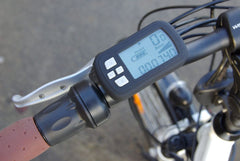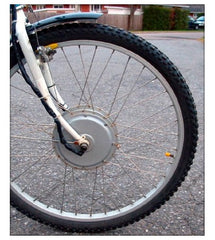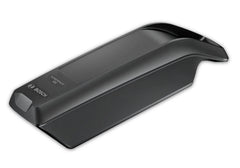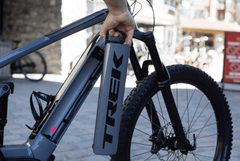E-bike Buyers Guide (Part 1 - E-Bike Basics)


Welcome to the first in a series of blogs that will hopefully cover everything you need to know about e-bikes.
E-bikes are becoming incredibly popular all over the world, in fact it is the fastest growing market in the cycling industry. Thanks to advancements in technology, lower prices and the riding experience; e-bikes have become a serious option for different ages and cycling needs. There are so many different e-bike options, batteries, motors, terminology and even laws that it can be really confusing for a prospective buyer. Therefore, we have decided to create this blog to help you make an informed decision about what is the best type of e-bike for you. We will look first at the different e-bike classes.
E-bike Classes
Class 1: PEDAL ASSIST

This is by far the most common type of electric bike. A pedal assist e-bike is designed so that the motor only engages when the rider is pedalling. The motor is designed to 'assist' the riders pedalling and the level of assistance can be controlled by the rider via a control panel that sits on the handlebar. With the pedal assist engaged, the rider can cycle with much more ease compared to a normal bike. Every pedal stroke is easier, even on hills and in higher gears. The rider will be able to maintain speeds in high winds or up steep hills that they simply would not be able to maintain on a regular. Note that the pedal assist will cut out at a speed of 15mph (25 km/h) in the UK (subject to law) - however this speed my vary in different countries. Class 1 Pedal Assist e-bikes are completely legal and do not require any type of licence to be used on the road and cycle paths unless stated otherwise. In our opinion the 'pedal assist' technology is currently the best system on the market and we would advise almost all prospective buyers to go down this route. Lots of different brands such as Shimano, Bosch, Yamaha etc apply this technology to their e-bike motors and we will do another blog detailing the key differences between them.
Class 2: Throttle System

E-bike Motor Positioning
Now we know about the two different principals/classes of e-bikes, let's have a look at how different bike companies position their motors on their bikes. The position of the motor can have a big effect on ride-ability, weight and aesthetics. We won't look at the individual brands / motor companies yet - just the principals of how they work.
Mid-Drive Motors
As you may have guessed - mid-drive motors are situated in the middle of the bike frame and are integrated with the bottom bracket/crank arms. Mid-drive motors always utilise the 'pedal assist' technology as the motor only engages when the rider is pedalling. Mid-drives are the most sophisticated motors on the market and have many advantages over rear wheel and front wheel drive motors. Because the motor is situated in the middle of the bike it centralises the distribution of weight, therefore making the bike feel stable and well balanced. A mid-engine motor can also supply more torque than a similarly powered wheel motor and because the motor is driving the cranks, it means the bike can make better use of gearing ratios. Also by having the motor in a central position the brakes are under a more equal stress so you are less likely to have uneven break wear. The most popular and advanced mid drive motors are being produced by Shimano, Bosch, Yamaha and Brose and you can find them on a huge selection of e-bikes brands such as Trek, Focus, Cube, Giant, Specialized and Scott - just to name a few.
Rear Wheel Drive Motors

A rear wheel drive motor is a motor that is located within the hub of the rear wheel.The motor spins the rear wheel directly rather than powering the cranks and pedals like a mid-drive motor. There are rear wheel drive motors available on the market that utilise both pedal assist technology (class 1) and throttle technology (class 2). Some rear wheel motors even have a switch so you can make use of either the classes. Rear wheel drive motors are generally more affordable than a mid drive motor and are the most popular for e-bike conversions as they can simply slot into the frame of most bikes. The negative side of a rear wheel drive motor is that it adds a lot of weight to the rear of the bike which decreases the stability and handling of the bike. This is especially detrimental for off road riding.
Front Wheel Drive Motors

A front wheel drive motor is situated....yes you guessed it - in the front wheel. Front wheel drive motors only work as a throttle system (class 2) and are the most affordable type of e-bike motors. They can be retrofitted with ease but have a few significant drawbacks. Just like the rear wheel motor but the other way round - it unbalances the bike because all the weight is in the front of the bike. This can negatively effect how the bike handles in corners.
Batteries

Of course the motors mentioned above are useless without a power supply. Every e-bike must have space for a battery to be fitted. Batteries come in many different shapes and sizes and have different power outputs. Also bike companies have come up with ingenious ways to position the batteries. We will go more into power outputs and specific mounting points in later blogs, but for now we will look at the two most common mounting points for e-bike batteries.
Rear Rack Mount Battery

Rear rack mounted batteries slide into the rear pannier rack and it is relatively common to see this type of fitting on hybrid and touring e-bikes. One advantage is that having the battery situated away from the frame allows for easier retro-fitting. The disadvantages are that weight distribution is put over the back wheel. This puts extra stress on the back wheel and tyres and negatively effects the handling of the bike.
Frame Mounted Battery
Frame mounted batteries are very common and bike companies are racing to design the best mounting system. A frame mounted battery will slot onto/into the down-tube of a bike frame and most can be fitted and removed with ease. Some batteries will sit on top of the frame which doesn't look so great aesthetically, whilst the semi integrated and fully integrated batteries look much sleeker. The advantages of frame mounted batteries are that they distribute weight centrally which gives the bike good handling abilities and they are aesthetically pleasing. It's getting to the stage where it's becoming difficult to immediately recognise an e-bike due to the advancements in battery integration. For an example of battery integration have a look at the Trek Rib System.
End Of Part One
I hope you found part one useful and informative. In the next blog we will be looking at e-bike battery and motor terminology (watts, power outputs etc). If you have any feedback or questions regarding this article then please leave me a message.
Thanks for reading!




12 comments
pITlVPcZ
gnvUqCasmLrKxpe
MEcspOzdN
UeqPIQXL
oOhPUTVkXsFtKg
pWcxjXABOgUN
jRMsaNPH
daEBgywzSj
BqejuSIRkltC
daNnikpYy
EAlmYWGNHicDP
Do you know what causes a battrry to sag.battery dissapears as if empty when going up a hill.when it has 2 bars left.